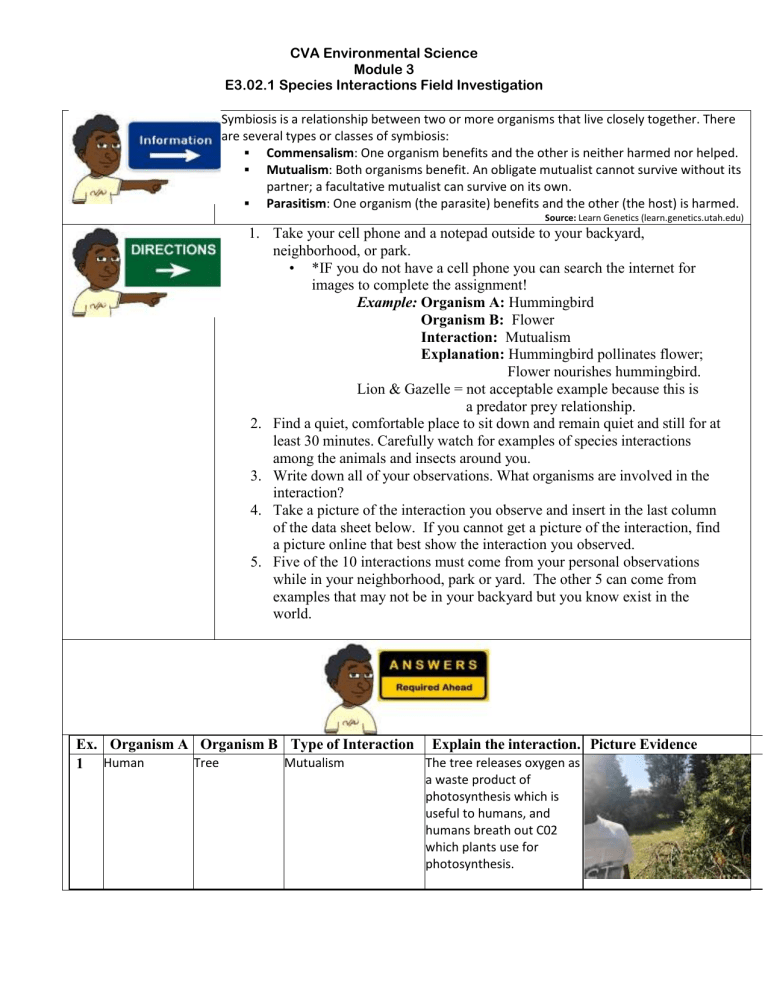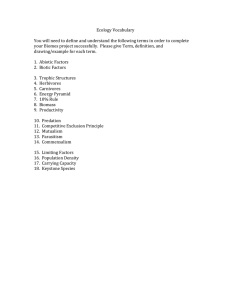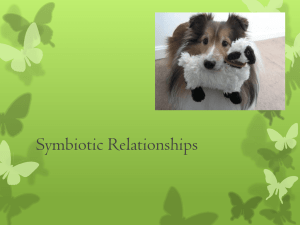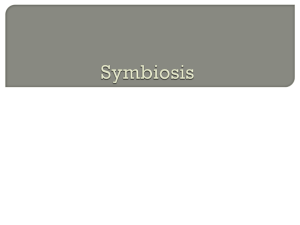
CVA Environmental Science Module 3 E3.02.1 Species Interactions Field Investigation Symbiosis is a relationship between two or more organisms that live closely together. There are several types or classes of symbiosis: Commensalism: One organism benefits and the other is neither harmed nor helped. Mutualism: Both organisms benefit. An obligate mutualist cannot survive without its partner; a facultative mutualist can survive on its own. Parasitism: One organism (the parasite) benefits and the other (the host) is harmed. Source: Learn Genetics (learn.genetics.utah.edu) 1. Take your cell phone and a notepad outside to your backyard, neighborhood, or park. • *IF you do not have a cell phone you can search the internet for images to complete the assignment! Example: Organism A: Hummingbird Organism B: Flower Interaction: Mutualism Explanation: Hummingbird pollinates flower; Flower nourishes hummingbird. Lion & Gazelle = not acceptable example because this is a predator prey relationship. 2. Find a quiet, comfortable place to sit down and remain quiet and still for at least 30 minutes. Carefully watch for examples of species interactions among the animals and insects around you. 3. Write down all of your observations. What organisms are involved in the interaction? 4. Take a picture of the interaction you observe and insert in the last column of the data sheet below. If you cannot get a picture of the interaction, find a picture online that best show the interaction you observed. 5. Five of the 10 interactions must come from your personal observations while in your neighborhood, park or yard. The other 5 can come from examples that may not be in your backyard but you know exist in the world. Ex. Organism A Organism B Type of Interaction Explain the interaction. Picture Evidence #1 Human Commensalism, Tree Mutualism The tree releases oxygen as Mutualism or a waste product of Parasitism photosynthesis which is useful to humans, and humans breath out C02 which plants use for photosynthesis. CVA Environmental Science Module 3 E3.02.1 Species Interactions Field Investigation 2 Bird Tree commensalism 3 Ants Grass Parasitism 4 Plant Sun Commensalism 5 Weed Plant Parasitism 6 Bee Flower Mutualism 7 Picabueyes Rhinos Mutualism 8 Mosquito Human Parasitism 9 Golden Jackals Tigers 10 Clownfish Sea anemone Commensalism Mutualism The bird uses the tree as shelter, not impacting the tree in any way. The ants create ant hills by burrowing in, which kills the grass in the area. The plant uses the sunlight to conduct photosynthesis, the sun is not affected The weed grows through the plant and takes away its nutrients. The bees get food in the nectar and spread the flowers seed by pollinating. The picabuey gets to eat the insects and parasites on the rhino and the rhino benefits from their absence. The mosquito feeds off the nutrients in the blood of humans which hurts humans and can lead to diseases. The jackal gets to feed off the remains of the tigers kills, not affecting the tiger. Clownfish keep sea anemone clean by eating dead tentacles and algae. that settle on the sea anemone. In this way both benefit Module 3 E3.02.1 Species Interactions Field Investigation CVA Environmental Science Module 3 E3.02.1 Species Interactions Field Investigation Species Interaction Investigation In this investigation numerous different interactions between these organisms have been observed. Some have been mutualistic such as the clownfish and the sea anemone, while others have been a parasite type relationship like the mosquito and the human. These relationships serve as the backbone of any ecosystem. We can see very critical relationships to the structure of our environment such as the bee spreading the pollen of the flowers so that the flower can reproduce. Additionally, the relationship between the tree and the sun is extremely important to the value of life on Earth. By the sun providing the necessary light to the plants for them to perform photosynthesis, which provides the plant energy and the organisms that eat the plant energy. In conclusion, these relationships are important to the sustainability of a successful environment and this investigation highlights how invaluable these relationships are even on the smallest of levels.







